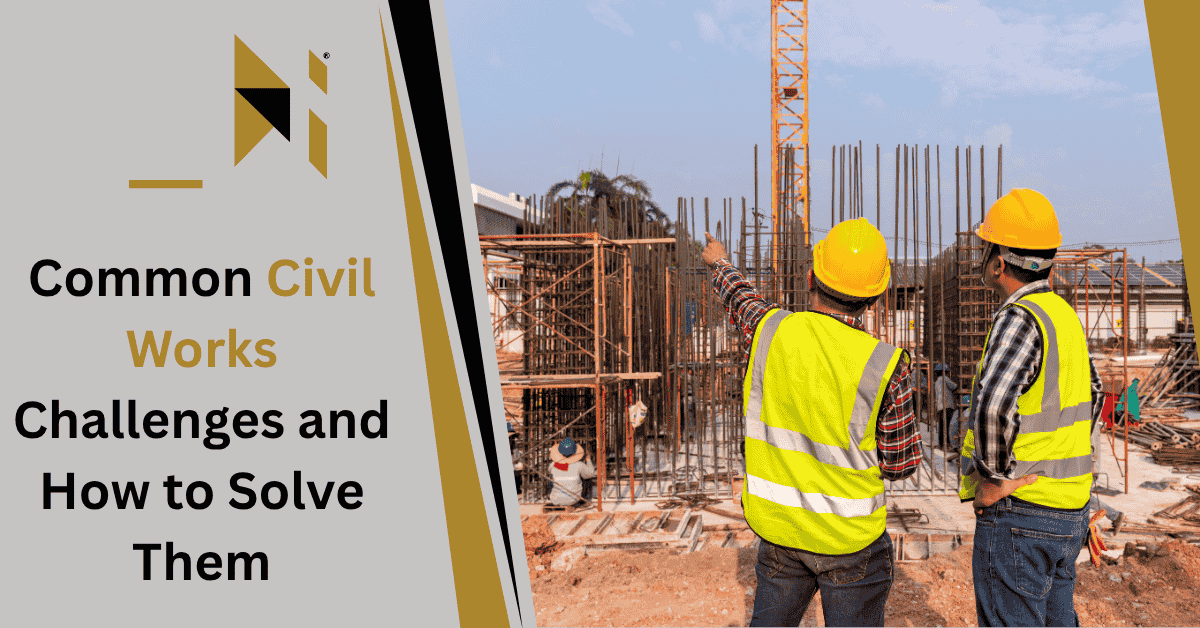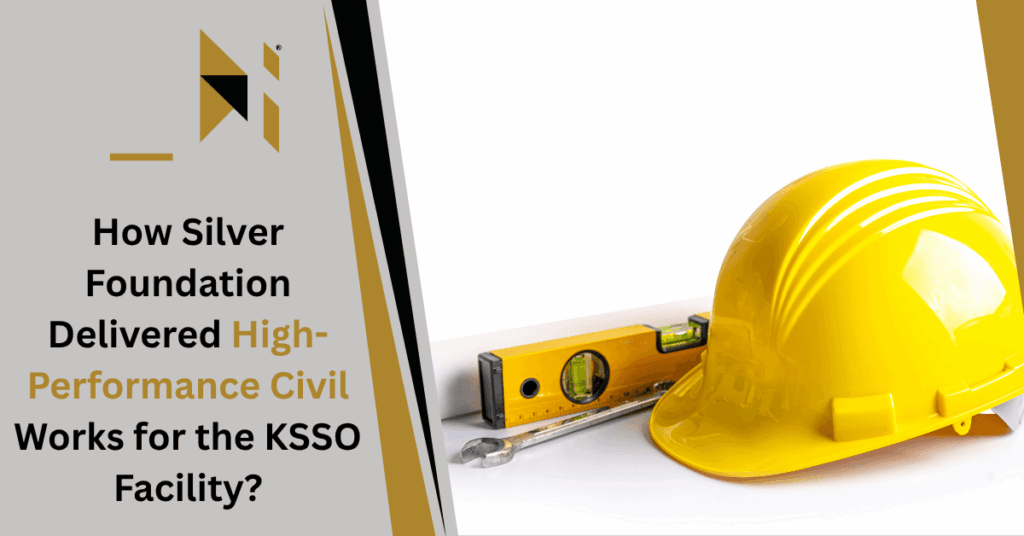Civil works, also known as civil construction, form the backbone of modern infrastructure. They revolve around the roads, bridges, drainage, water systems, and large-scale earthworks. These projects are often vast, technically demanding, and involve numerous stakeholders, from engineers to government agencies. Because of their complexity and scale, challenges such as unpredictable site conditions, coordination difficulties, and design adjustments are common. Silver Foundation has long been recognized for highlighting these issues and implementing the best solutions. This blog explores the most frequent problems encountered in civil works and outlines practical strategies to help engineers, contractors, and project managers mitigate them effectively.
Poor Site Investigation
Poor site investigation before the start of the construction is one of the most frequent problems in civil works. In the absence of good soil tests, topographical surveys, and groundwater investigation, the project may have a rocky foundation. This can cause issues with drainage, and the project will take unnecessary time.
To avoid these problems, a detailed geotechnical study is to be carried out at an early stage. These involve the collection of soil samples, analysis of the bearing capacity, and finding the underground utilities. When designers spend time on proper site data, engineers will be able to plan a stable foundation and foresee challenges prior to their arising.
Design Errors and Incomplete Drawings
Improper or incomplete design documentation usually causes confusion and rewriting in implementation. Such errors can be an outcome of poor planning or the insufficiency of coordination in design teams. The effect involves wastage of materials, delay on the project, and extra expenses.
The mitigation of such issues will require thorough reviews, peer reviews, and quality audits on designs. The introduction of Building Information Modeling (BIM) will guarantee the improved visualization, coordination and the detection of clashes. Periodic verification of the design by the senior engineers would also increase the accuracy and avoid the expensive mistakes at the site.
Project Delays
The delays in construction are common due to weather disturbances, materials shortages, improper scheduling, or delayed decision-making. Any delay escalates the costs of the project and influences credibility. Planners should make real schedules to handle time effectively, considering risks and contingencies.
Project management tools such as Primavera or MS Project are helpful in tracking the progress of a project and resource allocation. The project stays on schedule by monitoring the sites daily, solving the problems effectively, and communicating the issues across the teams very clearly.
Budget and Cost Overruns
Most civil works are strained financially when their estimates are overrun. Some of the causes are underestimated budgets, inflation, fluctuation in prices of materials and poor financial control. These overruns can decrease profitability and halt developments. The most efficient thing to do is to make elaborate cost estimates and provide rooms to unforeseen costs.
Periodic evaluation of financial position, open procurement policies and real-time cost monitoring applications aid in keeping the check. Budget management and early risk identification would make the project financially stable.
Labour Shortages and Low Productivity
Absence of skilled labour can have a devastating impact on construction. It is usually followed by poor workmanship, delay of time and poor results. In response to this, contractors should invest in the provision of ongoing skills training and provide reasonable wages that are accompanied by performance bonuses.
Productivity can also be increased, by introducing the mechanization of repetitive jobs and utilization of prefabricated parts. The positive working environment, worker welfare facilities and motivation allow for to retain experienced labour force and enhance the overall efficiency of the site.
Safety and Health Hazards
Construction areas are always dangerous by their nature. Accidents are common due to unsafe methods of construction, lack of supervision, or not offering protective equipment. These risks cause injuries, legal claims and stoppage of the projects.
The safety of workers should be one of the priorities. This includes periodic safety training, the use of personal protective equipment (PPE), and conducting safety audits. The presentation of safety signs, the maintenance of first-aid posts, and the culture of safety-first minimizes risks and guarantees that the labour regulations are considered.
Communication Gaps
Failure in communication between engineers, contractors, suppliers and clients tends to lead to misunderstanding, mistakes, and delays in the project. Unclear instructions and verbal communication only may also lead to significant variation on-site.
To avoid this, any communication, which concerns the project, must be recorded and provided in the form of centralized platforms or daily reports. Coordination meetings and digital platforms such as group chats on WhatsApp or project management software are a frequent occurrence as a way of keeping everyone informed.
Quality Control Problems
The structural integrity can be affected by poor quality of materials used, the absence of inspection or failure to meet design requirements. The usual resultant effects are cracks, leakages or premature wear of buildings. It is essential to put up stringent quality assurance measures. This will involve the application of approved materials, in-site testing and maintaining the checklists of inspections.
Third-party audits and laboratory tests also increase quality standards. Regular monitoring, compliance with specifications and extensive documentation will guarantee the project to be of desired durability and safety levels.
Environmental and Regulatory Problems
Delays in civil projects are usually experienced because of environmental constraints, permits, or failure to comply with local regulations. Issues such as mismanagement of waste, land-use contravention or water management disputes can command fines and reputational loss.
To avoid this type of setback, a proper environmental impact assessment should be the starting point of a project. It is necessary to comply with all the legal requirements, submit the permit applications in time and practice sustainable construction. Cases involving environmental consultants will make sure that the projects meet the local laws and that the environmental impact is minimized.
Technology Resistance
Even though the construction technology has advanced, there are still several workers and managers who are not willing to take up new digital tools like drones, project management software, or automated equipment. This indecisiveness leads to a lack of efficiency, no data tracking and slowness.
As a way of addressing this challenge, firms should implement easy-to-use technologies and offer practical training. Promotion of time and cost advantages leads to acceptance. An incremental approach to integrating and having supportive leadership is one of the strategies. They will encourage a culture of innovation and continuous improvement within the organization.
Best Practices to Follow for Smooth Civil Works
To achieve efficiency and quality in the civil works, start with thorough feasibility studies and design studies. This will help to foresee difficulties and maximize resources. Establish elaborate risk management and safety procedures to safeguard the workers and assets. Ensure good and transparent communication between all stakeholders, engineers, contractors, and clients. Weekly review of progress to ensure that problems are detected and solved in time to avoid unnecessary and costly delays. Use digital project management applications and mobile apps to report, document and update in real time. Document any changes in an organized manner and document any lessons learnt to enhance future project planning and implementation. By focusing on cooperation, technological inclusion, and active surveillance, it provides cost-efficient management and achieves long-term results.
Conclusion
The nature of the civil works will never be an easy task because of its complexity, size, and unpredictability. Nevertheless, all these problems can be mitigated through proactive planning, modern tools, appropriate communication, and an excellent risk management attitude. Silver Foundation urges engineers, contractors, and project leaders to implement fundamental strategies. Begin with small pilot programs to improve their methods of achieving smoother, safer, and more successful construction results.
Frequently Asked Questions
What is the most common civil works challenge?
The most common challenge is project delays caused by unforeseen site conditions, permit holdups, supply bottlenecks or scheduling misalignment.
How can cost overruns be controlled?
Use accurate estimation, include contingency, monitor cost in real time, enforce change order controls, and negotiate payment terms with contractors and suppliers.
Why do labour shortages affect civil projects?
Skilled workers are scarce due to an ageing workforce, limited training, and low entry incentives, leading to slow progress, quality issues, and higher wages.
How to improve safety on civil work sites?
Conduct safety training, use personal protective equipment (PPE), perform regular audits, implement hazard mitigation, and enforce strict safety protocols.




